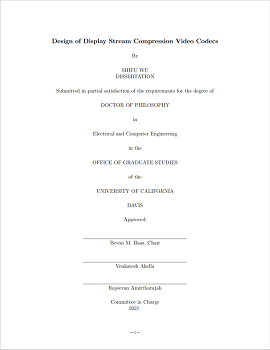 PDF (7.8 MB),
(c) Copyright, 2021
PDF (7.8 MB),
(c) Copyright, 2021
Shifu Wu
Ph.D. Dissertation
VLSI Computation Laboratory
Department of Electrical and Computer Engineering
University of California, Davis
Technical Report ECE-VCL-2021-3,
VLSI Computation Laboratory,
University of California, Davis, 2021.
Video displays with ultra-high-definition (UHD) resolutions such as 4K (3840 ×2160) and 8K (7680×4320) are now available. Video frame rates such as 120 frames per second (fps) and beyond are becoming more prevalent. Moreover, new display technologies have enabled wide color gamut (WCG) and high dynamic range (HDR). As a result, the required bandwidth to transmit uncompressed video data over display links has dramatically increased (e.g., 120 Gbps for 8K videos with 30-bit color at 120 fps); however, the physical layer bandwidth is not keeping pace with this demand. To address the disparity, a widely accepted low-cost solution is to compress the video streams prior to transmission and decompress upon being displayed. The Display Stream Compression (DSC) standard developed by Video Electronics Standards Association (VESA) enables low-cost and low-latency hardware implementations of visually lossless video codecs over display links. This dissertation analyzes the DSC algorithm, presents three hardware encoder architectures and the design of a fabricated and first published encoder chip, discusses four hardware decoder architectures and six decoder implementations, and describes the design of many-core software DSC decoders.
The DSC encoder hardware architectures for a slice encoder, a slice-interleaved encoder, and a time-interleaved encoder are presented. A DSC encoder chip based on the time-interleaved encoder architecture and supporting up to 4K video resolution is designed and fabricated in TSMC 28 nm CMOS technology. The chip is capable of processing two slices in parallel, resulting in a throughput of two pixels per cycle for 4:4:4 pixels, and four pixels per cycle for 4:2:2 and 4:2:0 pixels. The chip shares combinational computational resources across slices, requiring 627.7 K logic gates, yielding a 1.75 times logic area reduction. The time-interleaved encoding scheme lowers energy per pixel by 1.87–1.96 times compared to non-interleaved encoding at nominal voltage. At 1.15 V, the chip achieves up to 1448 megapixels per second (Mpixels/s) at 362 MHz, which is equivalent to 174.6 fps for 4K videos. At 0.8 V, it achieves 441 Mpixels/s for 4:2:2/4:2:0 pixels and 221 Mpixels/s for 4:4:4 pixels, while demonstrating a minimum energy of 84 pJ, 92 pJ, and 163 pJ per 4:2:0, 4:2:2, and 4:4:4 pixel, respectively. The chip achieves 2.7–33 times lower area and 2.0–45 times better throughput per area compared to prior video encoder chips.
Next, this dissertation presents four hardware architectures for DSC decoders. A slice decoder design realizes the DSC algorithm and achieves a throughput of three pixels per cycle for 4:4:4 pixels, and six pixels per cycle for 4:2:2 and 4:2:0 pixel formats. A slice-interleaved decoder architecture is proposed to support decoding of multiple columns of slices per picture with minimum area overhead. A parallel slice decoder architecture utilizes multiple parallel slice decoders to linearly increase the throughput. In addition, a parallel-interleaved decoder architecture offers area and throughput trade offs. To evaluate the proposed architectures, six decoders are implemented in 28 nm CMOS using a standard-cell-based design flow. The six implemented decoders support decoding of 1080p (1920 × 1080) videos, and require 169.6–627 K logic gates. At 1.0 V, the decoders operate at maximum frequencies of 495–610 MHz, achieve maximum throughput of 1490–13,040 Mpixels/s while dissipating 22.9–58.6 pJ per pixel. The slice decoder achieves five times higher throughput than prior work.
Furthermore, this dissertation presents the design of software DSC decoders on a fine-grained many-core processor array. The slice decoder exploits fine-grained task-level and component-level parallelism and can decode pictures configured into one column of slices; it is implemented with 88 processors and 2 memory modules. The parallel slice decoders facilitate higher performance by leveraging scalable slice-level parallelism; two designs that process two and four slices in parallel are implemented utilizing from 178 processors and 4 memory modules to 359 processors and 6 memory modules. At 1.75 GHz and 1.1 V, the proposed decoders decode 1080p videos in 4:2:0, 4:2:2, and 4:4:4 pixel formats—achieving up to 94.7 fps, 95.6 fps, and 47.9 fps. The minimum energy of 11.8 nJ, 13.3 nJ, and 23.4 nJ per 4:2:0, 4:2:2, and 4:4:4 pixel is achieved in the slice decoder at 0.76 V. The proposed designs achieve up to 159 times higher throughput and 769 times lower energy per pixel than a DSC decoder implemented on one core of an Intel i7-7700HQ processor.
 PDF (7.8 MB),
(c) Copyright, 2021
PDF (7.8 MB),
(c) Copyright, 2021Shifu Wu, "Design of Display Stream Compression Video Codecs," Ph.D. Dissertation, Technical Report ECE-VCL-2021-3, VLSI Computation Laboratory, ECE Department, University of California, Davis, September 2021.
@phdthesis{swu:vcl:phdthesis,
author = {Shifu Wu},
title = {Design of Display Stream Compression Video Codecs},
school = {University of California, Davis},
year = 2021,
address = {CA, USA},
month = sep,
note = {\url{http://vcl.ece.ucdavis.edu/pubs/theses/2021-3.swu/}}
}